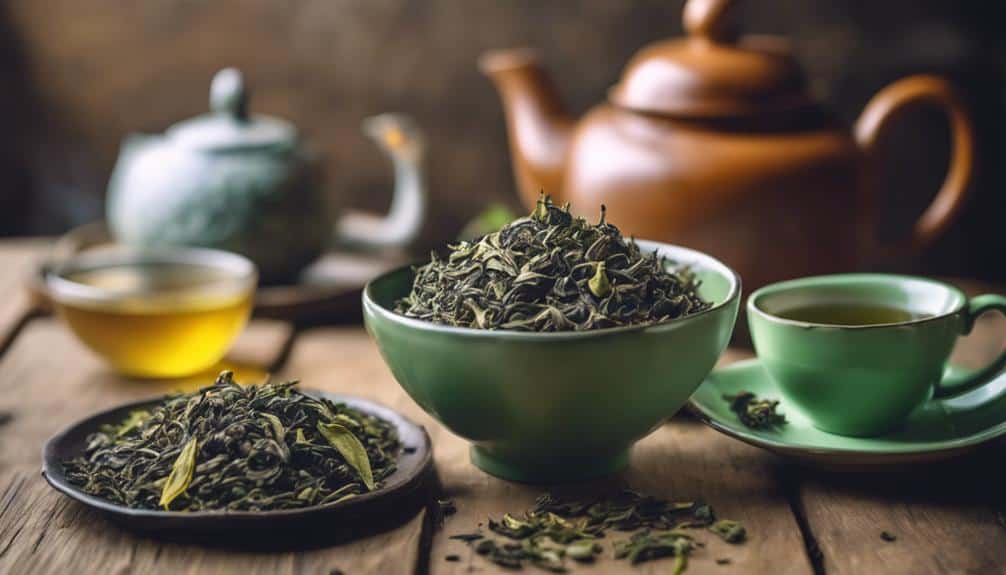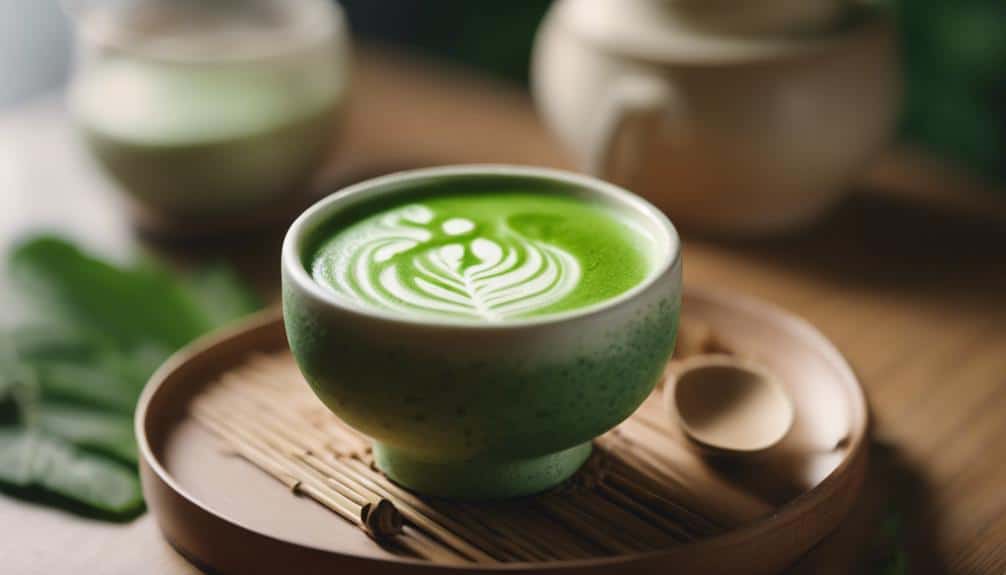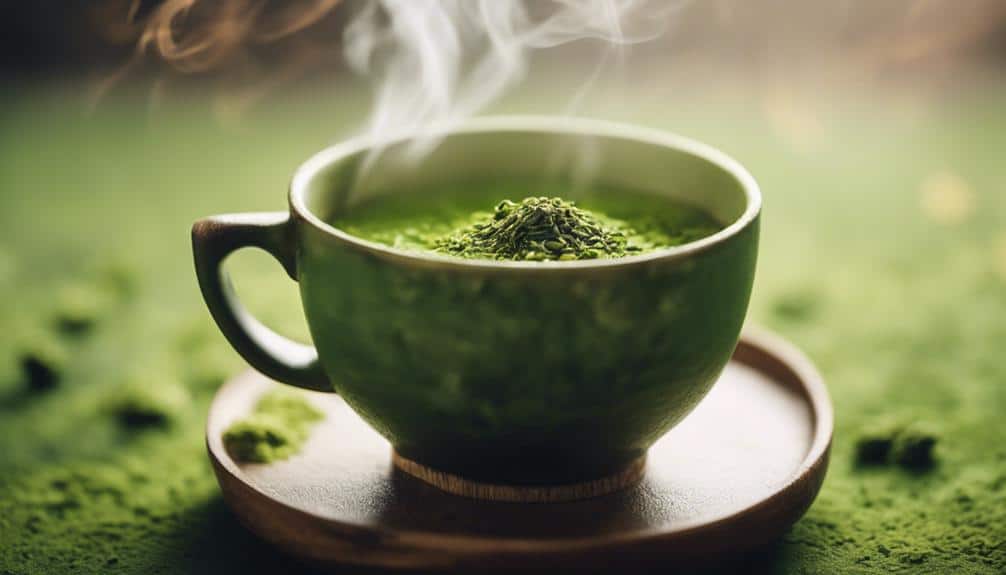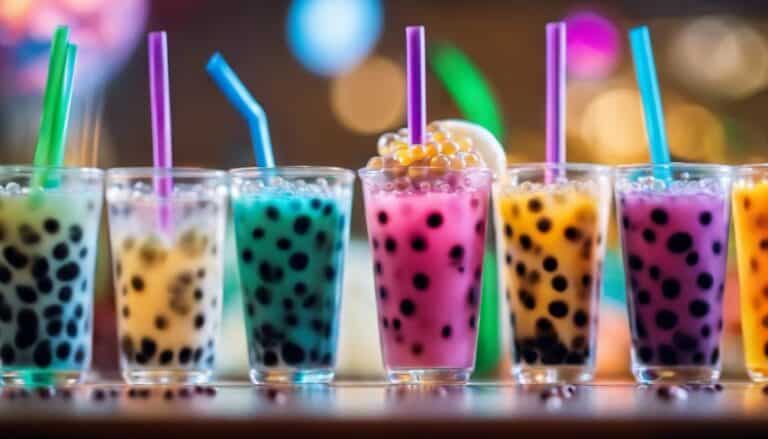Which Green Tea Is the Best to Drink?

As I sit here contemplating which green tea to choose from among the vast array of options available, a thought lingers in my mind: is there a definitive answer to the question of which green tea is truly the best to drink? With so many varieties and flavors to explore, each offering its own unique characteristics and health benefits, the journey to finding the perfect cup seems both exciting and challenging. Join me as we navigate the world of green teas, uncovering hidden gems and discovering what sets each apart in the quest for the ultimate tea-drinking experience.
Top Chinese Green Teas
Exploring the world of Chinese green teas reveals a diverse range of flavors and characteristics that cater to various preferences and palates. Among the top Chinese green teas, Longjing stands out with its flat, sword-shaped leaves and a flavor reminiscent of chestnuts. Originating from Zhejiang province, Gunpowder tea features rolled leaves that unfurl during brewing, offering a bold and smoky taste experience. These Chinese green teas are often pan-fired to halt oxidation, resulting in a fresh, vegetal taste with hints of nuttiness and sweetness.
Biluochun, a hand-harvested Chinese green tea, undergoes meticulous processing to maintain its delicate aroma and vibrant green color. On the other hand, Huangshan Maofeng showcases the unique terroir of Chinese green tea regions, boasting floral notes and a smooth, invigorating finish that sets it apart. The distinct characteristics of these Chinese green teas highlight the craftsmanship and diversity present in the world of green tea.
Popular Japanese Green Teas
Sencha, Matcha, Gyokuro, Genmaicha, and Hojicha are some of the top Japanese green teas with distinct flavor profiles.
Sencha offers a delicate taste with sweet earthy notes, while Matcha stands out for its vibrant green color and higher caffeine content.
Gyokuro, on the other hand, boasts a premium mellow taste with a sweet umami flavor due to being grown in shaded conditions.
Top Japanese Varieties
Among the array of popular Japanese green teas, one finds a delightful variety that caters to different tastes and preferences.
Sencha, with its delicate flavor and sweet earthy notes, stands out as the most consumed Japanese green tea.
Gyokuro, a premium shade-grown tea, offers a rich, sweet, and umami taste due to the shading process before harvesting.
Matcha, a powdered green tea, provides a concentrated flavor and vibrant green color, making it a favorite for many.
Genmaicha combines green tea with roasted brown rice, resulting in a nutty, toasty flavor with a hint of sweetness.
Lastly, Hojicha, a roasted green tea with a warm, toasty taste and low caffeine content, appeals to individuals of all ages seeking a comforting cup of Japanese green tea.
Flavor Profiles Compared
Comparing the flavor profiles of popular Japanese green teas reveals a diverse range of tastes and aromas that cater to various preferences. Here is a comparison table based on the facts provided:
| Green Tea | Origin | Flavor Profile |
|---|---|---|
| Rishi Sencha Green Tea | Kagoshima Prefecture | Delicate with sweet earthy notes |
| Vahdam Green Tea | Himalayas | Rich mellow taste with over 15 premium ingredients blended |
| Choice Organics Jasmine Tea | – | Perfectly balanced with jasmine flowers and sustainable packaging |
| Bigelow Classic Green Tea | – | Superior flavor, distinctive nuttiness from hand-picked leaves |
| Twinings Green Tea | Zhejiang Province | Light taste favored for its simplicity and quality sourced directly |
Best Matcha Options

When seeking the best matcha options, discerning consumers prioritize quality, vibrant color, and a harmonious balance of flavors for a truly authentic experience. Matcha is a high-grade powdered green tea renowned for its antioxidant content, providing a natural energy boost and potential health perks. It boasts a rich flavor profile and vibrant green color, indicative of its quality. Culinary grade matcha, like Jade Leaf Organic, offers versatility for culinary creations like smoothies, desserts, and lattes while maintaining its authentic taste.
Stone-ground from shade-grown tea leaves, matcha delivers a unique umami taste and smooth texture that sets it apart. For an excellent matcha experience, look for a product that strikes a balance between sweetness and bitterness, ensuring a delightful and genuine flavor profile. This careful selection process guarantees that each sip of matcha is a sensorial journey, combining the benefits of antioxidants, caffeine, and the distinctive qualities of this powdered green tea.
Organic Green Tea Choices
One top choice for organic green tea that stands out for its smooth taste and transparent, organic sourcing is Yogi Tea Green Tea Pure Green.
If you prefer a delicate flavor, Rishi Tea Sencha Green Tea from Kagoshima Prefecture, Japan, offers sweet earthy notes.
For a perfectly balanced flavor with sustainable packaging, consider Choice Organics Jasmine Green Tea.
If you seek a smooth taste blended with premium ingredients, Vahdam Green Tea from the Himalayas is handpicked and delivers a rich experience.
Twinings Green Tea, sourced from Zhejiang Province in China, provides a light and simple cup of green tea.
Each option offers unique qualities, from transparent sourcing to delicate flavors, catering to different preferences for organic green tea.
Whether you enjoy handpicked blends or sustainable packaging, these organic green tea choices provide a range of experiences to suit your palate.
Unique Tasting Green Teas

I've come across some rare tea varieties that offer truly exotic flavor profiles, each with its own unique characteristics.
From teas that are handpicked in the Himalayas to blends infused with jasmine flowers, there's a world of uncommon tastes waiting to be explored.
These teas might require unconventional brewing techniques to fully extract their distinct flavors, making each sip an adventure in itself.
Rare Tea Varieties
Exploring the domain of rare green tea varieties reveals a world of unique tasting experiences shaped by distinct growing conditions and meticulous processing methods.
- Longjing (Dragonwell) green tea is renowned for its flat, sword-like leaves and chestnut-like flavor profile, achieved through a precise pan-firing process.
- Gyokuro from Japan is shaded before harvesting, resulting in a sweet, umami taste with a vibrant green color, making it a sought-after delicacy.
- These rare green teas are handpicked and processed with precision to preserve their distinct flavors and aromas, appealing to tea connoisseurs for their exceptional quality.
- By delving into these unique tea varieties, enthusiasts can appreciate the diverse flavors and characteristics that different regions and cultivation techniques contribute to the world of tea.
Exotic Flavor Profiles
Rare green tea varieties open the door to an array of exotic flavor profiles, offering tea enthusiasts a palate-enlightening journey into the world of unique tasting experiences.
Green teas like Matcha Ceremonial Grade provide a rich umami flavor and vibrant green color, packed with antioxidants. Sencha tea, popular in Japanese tea ceremonies, delights with a grassy, vegetal taste and an invigorating finish. For those seeking a twist, Genmaicha combines green tea with roasted rice, offering a nutty flavor.
Kyoto Dew Matcha stands out for its premium quality, sourced from Japan's Kyoto region, delivering a delicate balance of sweetness and umami complexity. These exotic green teas cater to diverse preferences, from floral and fruity notes to smoky undertones, enriching the tea-drinking experience.
Uncommon Brewing Techniques
Utilizing unconventional brewing methods can elevate the tasting experience of green teas, offering a unique and diverse range of flavors and aromas.
- Cold brewing green tea: Steeping tea leaves in cold water extracts a smoother, less bitter flavor profile.
- Blooming teas: Hand-tied artisanal teas unfurl into beautiful floral shapes, providing a visually stunning and flavorful experience.
- Multiple steeps: Infusing green tea leaves multiple times brings out various flavor profiles, showcasing the tea's complexity.
- Blending varieties: Mixing different green teas creates custom flavor combinations, enhancing the taste and aroma for a personalized brewing adventure.
Specialty Green Tea Recommendations

In my experience, some notable specialty green tea recommendations include Rishi Tea Sencha Green Tea, Vahdam Green Tea from the Himalayas, Choice Organics Jasmine Green Tea, Bigelow Classic Green Tea, and Twinings Green Tea.
Rishi Tea Sencha Green Tea, hailing from Kagoshima Prefecture, Japan, is a certified organic, non-GMO option with a mild flavor and caffeine content, boasting sweet earthy notes.
Vahdam Green Tea from the Himalayas stands out for its minimal oxidation process, handpicked leaves, and a blend of premium ingredients resulting in a smooth, rich taste.
Choice Organics Jasmine Green Tea offers a well-balanced infusion of jasmine flowers, medium caffeine levels, and eco-friendly, sustainable packaging.
Bigelow Classic Green Tea, made from hand-picked leaves, features a distinctive nuttiness perfect for green tea baking enthusiasts.
Conclusion
To sum up, the best green tea to drink varies based on personal preferences and taste preferences. Whether you enjoy the antioxidant-rich Matcha, the delicate flavor of Sencha, or the unique experience of Gyokuro or Longjing, there's a green tea out there for everyone.
Exploring different varieties can enhance your appreciation for the diverse world of green teas and ultimately lead to finding the perfect cup that brings enjoyment and satisfaction with every sip.





